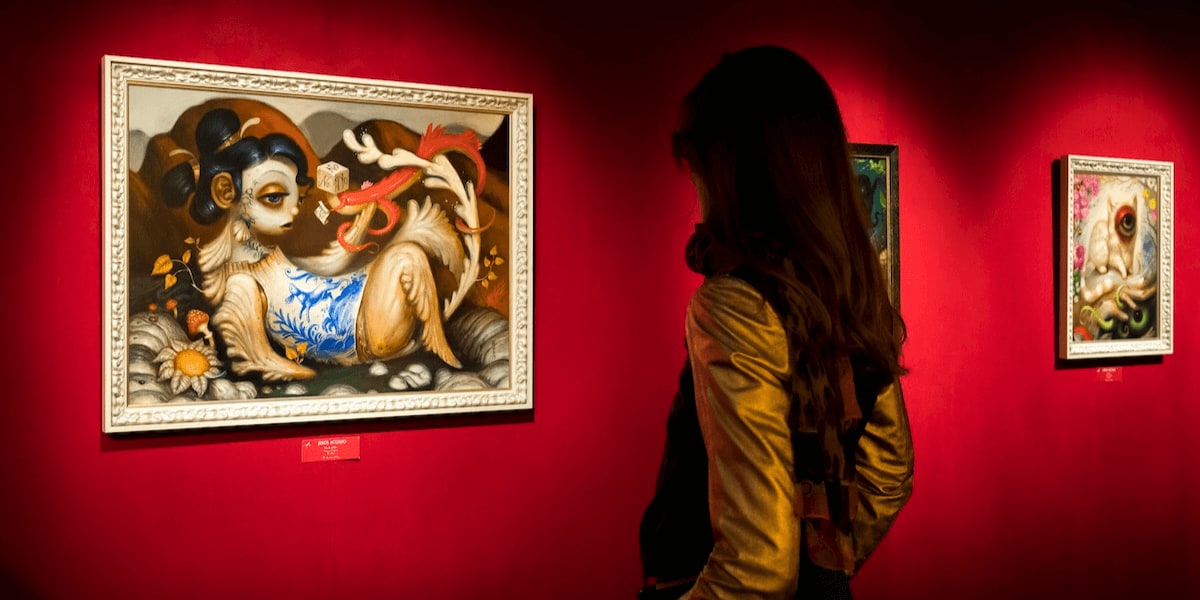
DCG: In "Cosmogony and Pets" there's a distinct fusion of the mythical with the everyday. Could you discuss the process of integrating these different worlds and what it reveals about your perspective on the everyday versus the fantastical?
JA: The exhibition "Cosmogony and Pets," like much of my artistic production, seeks to juxtapose meanings or seemingly contradictory elements to defy logic and explore the unexpected. It serves as a window into a realm of possibilities, where the unreal becomes tangible and the unknown is bravely confronted. Spectators are invited to immerse themselves in this universe of contrasts, where the beautiful and the grotesque intertwine in a visual dance to challenge expectations.

DCG: Your work serve as portals to the subconscious How do you conceptualize and construct this in your paintings, and what do you envision lies beyond them for the observer?
JA: The subconscious plays a crucial role in eliciting dramatic sensations, removing the need for detailed explanations of the artwork. It acts as the driving force behind the aesthetic experience, infusing every element with depth and mystery. The overwhelming feeling we get when observing the face of a woman in a state of Baroque mystical clairvoyance, surrounded by elements that are refreshing, impossible, or absurdly mundane, stems from a direct aesthetic impact on the subconscious. This effect is a blend of the familiar and the fantastic, the mundane and the transcendental.

DCG: Historical and artistic references play a significant role in your paintings. Can you talk about how you select these elements and the significance they hold in the context of your new series?
JA: Historical or post-apocalyptic and mythological themes play a crucial role in my paintings, enriching and adding depth. The new series of paintings invites reflection on the nature of existence and the mysteries of the universe. Each piece could be an exploration into the unknown and a reminder of the complexity of the world we inhabit. These "mysteries" have been a constant theme in art history, and I enjoy rescuing both the themes and aesthetics of the classics to then infuse them with other contemporary elements. In this way, a dialogue is created between the past and the present, with a touch of humor that connects with the viewer in a more natural way.

DCG: The classical style of your art brings a timeless quality to modern subjects. How do you balance tradition and innovation in your technique, and what do you believe this balance brings to your work?
JA: As an illustrator with nearly two decades of experience, I have dedicated the majority of my career to the digital realm, prioritizing practicality, conceptual clarity, simple aesthetics, and visual appeal in each creation. However, my work as a painter represents for me an urgent need for creative balance. It emerges as a counterforce to my work as an illustrator, fulfilling my artistic needs and concerns.
In my painting, I embrace a classical style that transcends temporal trends, where the representation of objects is free from any aesthetic artifice. Each piece tells stories in a raw and direct manner, as if they were fragments unfolding before the viewer in a strangely honest way.

DCG: Your pieces are seem to challenge viewers to decipher enigmatic narratives. What advice would you give to those attempting to unravel the stories within your paintings, and what do you hope they take away from the experience?
JA: On numerous occasions, in my paintings, I hint at "clues" that invite the viewer to unravel an enigma. For example, in the artwork "LUCA," could it be that the floating organism near the female figure represents the Last Universal Common Ancestor, the ancestor that supposedly gave rise to all life on that imaginary planet?
However, beyond such interpretations, it is of paramount importance to me that the viewer immediately immerses themselves in the visual universe I propose. The subtle play with the absurd encourages this immersion, and I consider the viewer's perception to be as valid as any explanation I, as the artist, could offer. It is in this interaction where the true magic of art resides, where each gaze is unique and each interpretation enriches the aesthetic experience.


